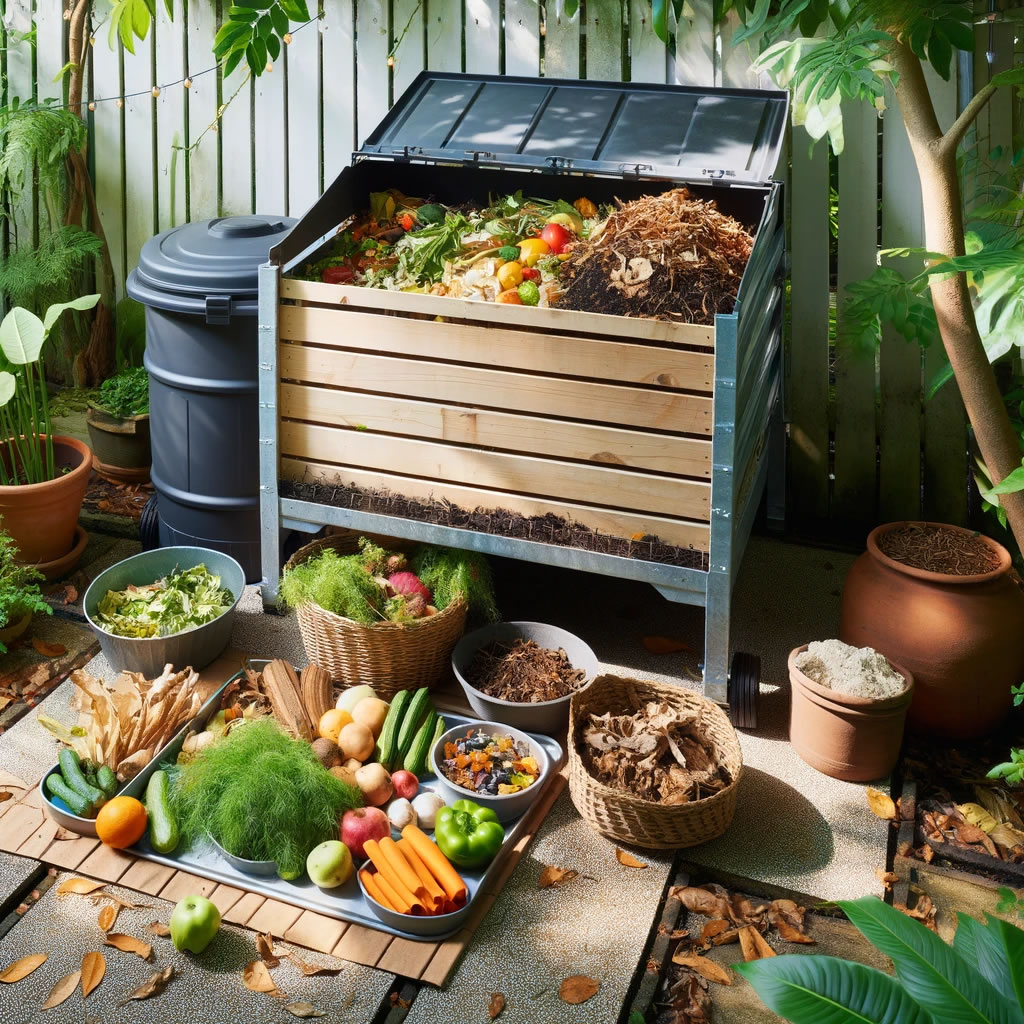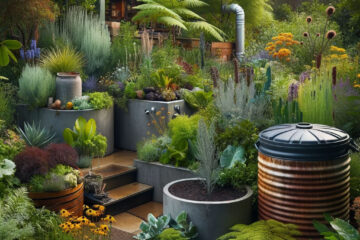Home composting is an environmentally friendly practice that transforms kitchen scraps and yard waste into valuable, nutrient-rich compost.
It’s a simple yet effective way to reduce household waste and contribute to a sustainable lifestyle.
Home Composting not only decreases the amount of garbage sent to landfills but also provides an excellent soil amendment for gardens, enhancing soil health and plant growth.
Environmental Benefits
Composting organic waste helps reduce greenhouse gas emissions, particularly methane, which is produced when organic matter decomposes anaerobically in landfills.
By Home Composting, you’re actively participating in reducing your carbon footprint.
Table of Contents

Gardening Advantages
Compost is often referred to as ‘black gold’ by gardeners due to its rich nutrient content. It improves soil structure, provides essential nutrients to plants, and helps retain soil moisture.
Whether you’re a seasoned gardener or just starting, using homemade compost can significantly boost your gardening success.
Educational Aspect
Engaging in Home Composting can be a great educational experience for all ages.
It offers practical lessons in sustainability, biology, and environmental stewardship, making it an excellent activity for families.
Starting a compost pile at home is a straightforward and rewarding process, contributing positively to both the environment and your garden.
Setting Up Your Compost Bin

Choosing the right spot and type of compost bin is crucial for successful Home Composting.
As highlighted in the Mashable article, the location of your compost bin can significantly impact its effectiveness. Here are some key considerations for setting up your compost bin:
Selecting the Location
Place your compost bin in a partially shaded area to prevent it from drying out on sunny days or getting too wet in rainy weather.
Direct contact with soil is preferable, as it allows worms and microbes to access and aid in the Home Composting process.
Choosing the Right Bin
Home Composting bins come in various sizes and materials. For smaller spaces, a compact plastic bin might be ideal.
If you have more room, you can opt for larger wooden bins or even consider building your own. Ensure the bin is easily accessible for adding materials and turning the compost.
Preparing the Bin
Start by placing a layer of twigs or straw at the bottom to aid in drainage and aeration. This base layer is crucial for maintaining a healthy Home Composting environment.
Setting up your compost bin correctly is the first step towards efficient and hassle-free composting.
With the right setup, you can look forward to creating your own nutrient-rich compost for your garden.
What to Compost: Dos and Don’ts

Knowing what to compost is essential for maintaining a healthy compost pile.
The Lomi guide provides valuable insights into the types of materials suitable for composting. Here’s a breakdown of what you can and cannot compost:
Compostable Materials (Dos):
Green Waste
Includes kitchen scraps like fruit and vegetable peels, coffee grounds, and eggshells. These materials are rich in nitrogen and help to speed up the Home Composting process.
Brown Waste
Consists of dry leaves, straw, wood chips, and shredded newspaper. These carbon-rich materials balance the nitrogen in green waste and add structure to the compost pile.
Other Organic Matter
Grass clippings, plant trimmings, and certain types of manure (such as cow, horse, chicken, or rabbit) can also be added.
Non-Compostable Materials (Don’ts):
Meat and Dairy Products
These can attract pests and cause unpleasant odors.
Diseased Plants
Avoid composting plants with diseases or insect infestations, as these can spread to the compost.
Pet Waste
Dog and cat feces can contain harmful pathogens and should not be added to compost.
Pro Tip
Maintain a balance between green and brown materials in your compost pile. A mix of about 50:50 is ideal for efficient decomposition and odor control.
By carefully selecting what you add to your compost pile, you can ensure it remains healthy and productive, eventually turning into a valuable resource for your garden.
Maintaining Your Compost Pile

Effective maintenance is key to a successful composting process.
As outlined by the US EPA, proper care of your compost pile ensures it breaks down materials efficiently and produces high-quality compost.
Here are some essential tips for maintaining your compost pile:
Balancing Materials
Keep a good balance between green (nitrogen-rich) and brown (carbon-rich) materials. If your compost is too wet and smelly, add more browns; if it’s too dry, add more greens.
Aeration
Regularly turn your compost pile to introduce oxygen, which is crucial for composting. Use a garden fork or a compost aerator to mix the materials.
This helps to speed up the decomposition process and prevents the pile from becoming too compacted.
Moisture Control
Your compost should be moist, but not too wet. The consistency should be like a wrung-out sponge.
If it’s too dry, add water or green materials; if it’s too wet, add brown materials or turn it more frequently to dry it out.
Monitoring Temperature
A healthy compost pile will generate heat. If it’s not heating up, it might need more green materials, water, or turning.
Size of Materials
Chop or shred larger items before adding them to your compost pile. Smaller pieces decompose faster.
By regularly monitoring and adjusting these elements, you can ensure your compost pile decomposes effectively and transforms into nutrient-rich compost for your garden.
Troubleshooting Common Composting Issues
Even with careful maintenance, you might encounter some common issues in your composting journey.
Understanding how to identify and resolve these problems will help you maintain a healthy compost pile.
Here are solutions to some typical composting challenges:
Compost Pile Not Heating Up
If your compost pile isn’t heating up, it might lack nitrogen. Add more green materials like kitchen scraps or grass clippings.
Also, ensure the pile is moist and turn it to improve aeration.
Bad Odor
A stinky compost pile is usually a sign of too much moisture and not enough air.
Turn the pile to introduce oxygen and add brown materials like dry leaves or straw to absorb excess moisture.
Attracting Pests
To avoid attracting rodents and insects, do not add meat, dairy, or oily foods to your compost. Always cover fresh kitchen scraps with a layer of browns like leaves or straw.
Slow Decomposition
If your compost is breaking down too slowly, it may need more green materials, water, or turning.
Chopping up larger items before adding them to the pile can also speed up the process.
Mold and Fungus
The presence of mold and fungus is a normal part of the composting process, breaking down organic material.
However, if it becomes excessive, adding more browns can help balance the pile.
By addressing these common issues, you can keep your compost pile healthy and productive, eventually yielding rich compost for your garden.
Front Questions for the Article
What do I need to start composting at home?
To begin composting, you’ll need a compost bin or designated area in your yard, a balance of green (nitrogen-rich) and brown (carbon-rich) materials, and a tool for turning or aerating your compost.
Can I compost if I live in an apartment?
Yes, you can compost in an apartment using a small indoor compost bin or worm composting system. Be mindful of what you add to avoid odors and pests.
What materials can I put in my compost pile?
Include green materials like fruit and vegetable scraps, coffee grounds, and eggshells, and brown materials like dry leaves, straw, and shredded newspaper.
Avoid meat, dairy, diseased plants, and pet waste.
How often should I turn my compost pile?
Turn your compost pile every few weeks to aerate it, which speeds up the Home Composting process. If your compost is very wet or smelly, you may need to turn it more frequently.
How do I know when my compost is ready to use?
Compost is ready when it’s dark, crumbly, and has an earthy smell. It typically takes a few months to a year to fully decompose, depending on the conditions.
What are common problems in Home Composting, and how can I solve them?
Common issues include the compost pile not heating up (add more greens), bad odors (add more browns and turn more frequently), attracting pests (avoid meat and dairy, cover new additions with browns), and slow decomposition (turn more often and chop materials into smaller pieces).
Is it normal for my compost to have bugs and worms?
Yes, it’s normal and beneficial for your compost to have insects and worms, as they help break down organic material.
However, if you notice an overabundance of pests like flies, check your balance of greens and browns.



